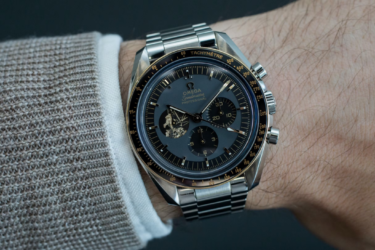Just over 50 years ago an individual named Buzz Aldrin, wore the Omega Speedmaster professional when stepping on the moon. The Omega Speedmaster as a result became one of the most iconic timepieces in history.
But that’s not the full story. It was one small step for man, and one giant leap for watch-kind… here’s the story of the first watches on the moon.
The Omega Speedmaster Moonwatch: A Brief History

Image Credit:
So, this was technically not the first Omega in space, but it was the first NASA-certified watch in space.
In 1962, Walter ‘Wally’ Schirra wore his Speedmaster CK2998 in space. However, this was his personal watch and therefore had nothing to do with NASA.
In 1964, NASA in fact opened up the search for the space watch. Omega, alongside Rolex, Longines and Hamilton was contacted by NASA to provide a quote for the watches to accompany astronauts to space. Omega provided NASA with the reference 105.003 and the rest became history.
The Ed White Speedmaster

Image Credit: Chrono24
The reference 105.003, or the Ed White, was the first watch to be used during a spacewalk.
This model sports straight lugs and no crown guards, giving it a minimal and sleek appearance. Nowadays, the traditional Ed White Speedmaster can be seen with beautiful patinated hands and faded bezels.
This watch became so iconic as well, that now Omega has released an Ed White reissue to commemorate this occasion, it has very similar design features but with a new 321 movement.
However, that’s beside the point. The Ed White Speedmaster CK2998 was the first NASA-certified watch on the moon and therefore holds a key part of history.
The Apollo 11 Speedmaster

Image Credit: Hodinkee
The reference that went to space in 1969 began to show similarities to the Speedmasters of today. The 42mm case also sported crown guards and much wider pushers. Neil Armstrong famously wore this reference during the Apollo 11 mission.
To this day, however, this watch cannot be found and proves to be a mystery in its disappearance. For sure, if this watch ever resurfaced it would demand an extremely hefty price at auction. Instead, it remains one of the most important watches and the biggest mysteries in the history of the industry.
After this reference, Omega continued to provide watches for NASA and their space missions.
In 1978 Omega was asked to provide NASA with watches for the Space Shuttle Program of 1981. This time, however, Omega had competition from thirty other brands. Omega, due to their previous relationship with NASA, won the bid and was able to provide watches for this mission as well.
The Modern Years
Recently in 2012, Omega once again provided an astronaut with a watch, this time NASA’s Russian astronaut, Gennady Padalka, who spent 879 days in space.
In 2017, this exact Speedmaster was auctioned and fetched $39,458.48. It’s safe to say that not only does the Speedmaster play a key role in watch history but also in the history of humankind.
The Speedmaster was the first watch on the moon and will forever be intrinsically linked to space travel and ground-breaking science. Although Omega Speedmasters have become a common part of many collections, it takes nothing away from how special they truly are.
No doubt, the Speedmaster played an important role for watches and for Omega, they continue to reign supreme within the watch industry.




